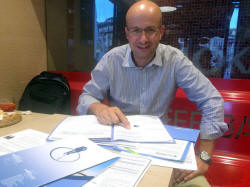|
How EU fund rules leave
gaps in investor protection
 Send a link to a friend
Send a link to a friend
 [October 17, 2016]
By Danilo Masoni [October 17, 2016]
By Danilo Masoni
PAVIA,
Italy (Reuters) - Pietro Maffi routinely checks his financial statements
and has a good understanding of how his savings are being managed. At
least he thought he did until he read the small print.
Maffi, a software engineer from the northern town of Pavia, invests in
funds managed by Banca Mediolanum <BMED.MI>, an Italian bank. He knew
one of those funds was based not in Italy, but in Ireland. What he
didn't know until recently was that the fund uses a fee structure that
is not allowed in Italy, and is out of line even with Ireland's own
investor protection guidelines, which are non-binding.
That structure meant the fund generated 34.7 million euros in
performance fees for Mediolanum in 2015, according to company filings,
while the value of Maffi's account fell 0.5 percent.
"The problem is there are so many papers to go through and it's
difficult to spot all details," Maffi said as he pored over documents
looking for performance fees charged to his account.
Massimo Doris, chief executive of Mediolanum, told Reuters that the
bank's fee structure was "perfectly legal" and that the Irish central
bank had approved its funds. The Central Bank of Ireland declined to
comment on specific cases.
Maffi's difficulties illustrate how Europe's 21 trillion euros ($23
trillion) asset management industry can shop around for regulators,
creating gaps in investor protection. Managers can choose to have their
funds overseen in another European Union (EU) country that allows them
to charge fees that wouldn't be permitted at home. It means they can
legally circumvent the rules imposed in their own country.

Under EU single-market rules, funds regulated in one member nation can
be marketed across all of the bloc's 28 countries despite differences in
rules. Ireland and Luxembourg are the two most coveted jurisdictions,
with both offering tax advantages.
In addition, Ireland has regulatory guidelines on fees that are not
binding; and Luxembourg has no specific regulations on fees of its own,
but says it applies the principles from the International Organisation
of Securities Commissions (IOSCO).
Mediolanum chief Doris said the Italian firm had decided to set up funds
in Ireland because of the Central Bank of Ireland's speedy approval
process. He said Mediolanum had not based funds in Ireland in order to
exploit looser fee regulation. Doris said fees were a significant issue,
but long term performance was more important. "It's much, much, much
more important how you guide clients," he said.
However, he said after receiving Reuters questions that the bank was now
reviewing its fee structure.
As well as going beyond Italian regulations, Mediolanum's fee structure
does not follow the non-binding guidelines in Ireland. Doris said he had
not been aware of the Irish guidelines, noting that they had only been
published on the central bank's website last year.
He said Mediolanum would take a decision on its fee policy within a few
months. The review was triggered by a recent update to "good practice"
guidelines on fees from the IOSCO. "If we're going to adjust to the new
IOSCO recommendations, it's certain that we would also be in line with
the Central Bank of Ireland's guidelines," Doris said.
Katie Philpott, a spokeswoman for the Central Bank of Ireland, said any
arrangements on the payment of performance fees should be consistent
with its guidelines. "You have raised issues of a specific nature which,
where appropriate, the central bank will follow up with entities
directly," Philpott wrote in an email.
Under the EU system, any member state can stop funds from being sold in
its home market if it believes managers have moved funds abroad in order
to bypass its stricter rules. However, the watchdog overseeing Italian
financial markets –the Commissione Nazionale per le Società e la Borsa (Consob)
- declined to comment when asked if it was concerned about Italian funds
being based abroad and charging fees that would not be allowed at home.

LOW HURDLES
Performance fees are levied in addition to standard annual fees for
managing funds. Maffi said regulators should require fund managers to
spell out fee structures and their impact clearly rather than put them
in the lengthy detail of a fund prospectus. His savings vehicle, the
Coupon Strategy Collection LH fund, explained the performance fee in the
last part of a 270-page prospectus, and in a separate investor document
published once a year.
[to top of second column] |

Pietro Maffi, a software engineer from Italy, poses over his
investment statements during an interview with Reuters in a cafe in
Pavia, Italy, September 21, 2016. REUTERS/Danilo Masoni

The
fund charged a fee of 0.8 percent of the fund's gross asset value if it exceeded
a specific investment hurdle each month. But the hurdle was set low: the fund
had to make gains of more than the euro interbank lending rate – which has been
below 0 percent for 17 months.
One of
Mediolanum's worst performing funds last year was its Challenge Emerging Markets
Equity Fund SA, which fell 8.3 percent in 2015. It charged a 1.42 percent
performance fee, using the same euro interbank lending rate, Euribor 3, as its
benchmark. It was able to charge the performance fee because during certain
months of the year its performance was positive.
If
based in Italy, Mediolanum's emerging markets fund could not have charged a
performance fee in 2015 because Italian investor protection rules require such
fees to be calculated on the performance of at least one year.
Luca Enriques, corporate law professor at Oxford University and a former
commissioner at Consob, said regulatory disparities at a national level need to
be ironed out with EU-wide enforcement.
"The
only way to avoid such dysfunction would be to centralize regulation and
enforcement of the rules with ESMA (the European Securities and Markets
Authority)," he said. He added that the rules would need to offer appropriate
investor protection and be effectively enforced.
ESMA declined to comment on whether fragmented regulation had harmed investors.
It said its role in "developing a single rulebook for EU financial markets and
ensuring the consistent application of those rules across the EU, ensuring
common approaches, will contribute to enhancing protection for EU investors."
At
present a large number of funds take advantage of the different rules in
different jurisdictions. More than 6,000 investment funds have been set up in
Ireland's capital, Dublin. More than 14,000 funds are domiciled in Luxembourg.
Reuters looked at funds in Italy because it has a large and relatively
unsophisticated market of retail investors. Many Italian savers have been
encouraged by local managers or advisers to invest in funds based in Ireland or
Luxembourg. Reuters has not studied the fee policies of major fund managers
elsewhere in the EU.

Shares of Italy-based managers have been sensitive to issues concerning
performance fees. Mediolanum made 326 million euros in performance fees last
year, or 0.46 percent of its overall assets under management, a larger
proportion than many other big European managers. That sum was nearly one fifth
of Mediolanum's total revenues.
Italian fund managers Azimut and Banca Generali, which have based many of
their funds in Luxembourg, charged performance fees of 0.43 percent and 0.31
percent, respectively, as a proportion of assets under management. Banca
Generali said it started to base funds in Luxembourg eight years ago because at
the time clients paid higher tax on funds based in Italy. Azimut declined to
comment.
For the UK's Henderson Group, performance fees were 0.11 percent of assets under
management; for France's Amundi , 0.01 percent; and for Switzerland's GAM
Holding, 0.07 percent.
($1 = 0.8928 euros)
(Additional reporting by Maria Pia Quaglia; Editing by Mark Bendeich, Simon
Robinson and Richard Woods)
[© 2016 Thomson Reuters. All rights
reserved.] Copyright 2016 Reuters. All rights reserved. This material may not be published,
broadcast, rewritten or redistributed. |